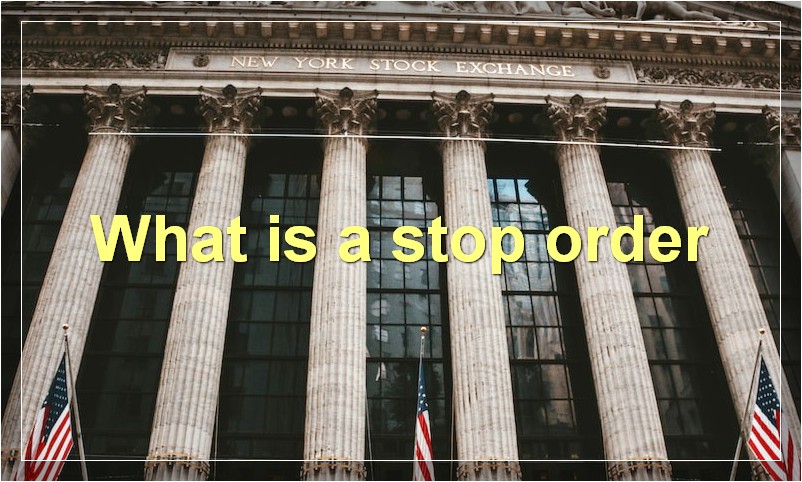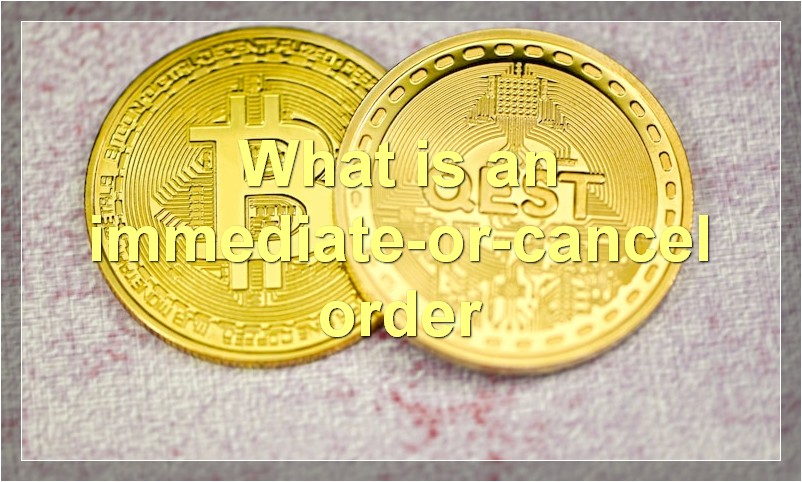If you’re new to investing in stocks, the process of placing an order may seem daunting. But it’s actually quite simple once you understand the different types of orders.
What is a limit order
When it comes to trading stocks, there are various types of orders that can be placed. These include market orders, limit orders, and stop orders. Each type of order has its own purpose and can be used in different ways to help you execute your trade strategy. In this article, we’ll take a closer look at limit orders and how they can be used when trading stocks.
A limit order is an order to buy or sell a security at a specified price or better. A buy limit order can only be executed at the limit price or lower, while a sell limit order can only be executed at the limit price or higher. Limit orders are typically used when an investor wants to buy or sell a stock at a specific price and is not concerned with getting the best possible price.
For example, let’s say you wanted to buy shares of ABC Corporation at $10 per share. You would place a buy limit order for ABC stock at $10 per share. If the stock trades at $10 or lower, your order will be executed. However, if the stock trades above $10 per share, your order will not be executed.
Limit orders give you more control over your trade than market orders, but they also come with some risks. If you place a limit order to buy shares of a stock and the stock price never reaches your limit price, your order will not be executed. Additionally, limit orders may not be filled immediately if the stock price is not currently trading at your limit price.
Overall, limit orders can be a useful tool for investors who want to control the price they pay for a stock. However, it’s important to remember that limit orders are not guaranteed to be filled and may take some time to execute.
What is a stop order

A stop order is an order to buy or sell a security at a specified price. A stop order is triggered when the security’s price reaches the specified price and is executed at that price.
Stop orders are often used to limit losses or protect profits. For example, if you own shares of a stock that you bought for $50 per share, you might place a stop order at $45 per share. If the stock price falls to $45, your stop order will be triggered and your shares will be sold at $45. This will limit your loss on the position to $5 per share.
Stop orders can also be used to protect profits. For example, if you own shares of a stock that you bought for $50 per share and it is now trading at $60, you might place a stop order at $65. If the stock price rises to $65, your stop order will be triggered and your shares will be sold at $65. This will lock in a profit of $15 per share.
There are two types of stop orders:
• Stop-loss orders: These orders are used to limit losses on a position. A stop-loss order is triggered when the security’s price falls to the specified price and is executed at that price.
• Stop-limit orders: These orders are used to protect profits or limit losses. A stop-limit order is triggered when the security’s price reaches the specified price and is then executed at the limit price or better.
What is a market order
A market order is an order to buy or sell a security at the current market price. Market orders are the most basic type of trade and are used to enter or exit a position quickly. When you place a market order, you are instructing your broker to buy or sell a security at the best available price.
Market orders are not guaranteed to fill at the exact price you want. The price of a security can change rapidly, and depending on the liquidity of the security, your order may be filled at a different price than you expected. For this reason, market orders are best used when you do not have a specific price target in mind, and you are comfortable with accepting the market price.
If you want more control over the price you pay for a security, you can use a limit order. With a limit order, you specify the maximum (or minimum) price you are willing to pay (or accept) for a security. Your order will only be filled at this price or better. If the security is not trading at your limit price, your order will remain open until it is triggered by the security reaching your limit price.
What is a stop-limit order
A stop-limit order is an order to buy or sell a security at a specified price or better, after the security reaches a specified stop price. Once the stop price is reached, the order becomes a limit order to buy or sell at the limit price or better.
What is an all-or-none order
An all-or-none order is an order to buy or sell a security that must be fulfilled in its entirety, or not at all. All-or-none orders are typically used by investors who want to ensure that they either get the entire order filled at the desired price, or none of it.
For example, let’s say an investor places a buy all-or-none order for 100 shares of XYZ stock at $10 per share. If the stock is trading at $10 per share and there are enough shares available, the order will be filled and the investor will receive 100 shares. However, if the stock is trading at $9.50 per share, the order will not be filled because the investor’s desired price has not been met.
All-or-none orders can be placed for both buy and sell orders. They are typically used for large orders, and come with some risk because if the price of the security moves against the investor, the entire order may not be filled.
What is an immediate-or-cancel order

An immediate-or-cancel order (IOC) is an order to buy or sell a security that must be executed immediately, and any portion of the order that cannot be filled immediately will be canceled.
IOC orders are typically used when an investor wants to ensure that an order is filled as quickly as possible. For example, if an investor is trying to buy a stock that is trading at $10 per share, but there are only 500 shares available for purchase, they may place an IOC order for 1,000 shares. In this scenario, the investor would likely only have their order for 500 shares filled, as that is all that is available for purchase, but they would be guaranteed to get those shares immediately. The other 500 shares would be canceled.
If you are looking to place an IOC order, it is important to keep in mind that not all brokers offer this type of order, so you may need to find one that does before you can place your trade. Additionally, it is important to understand that most IOC orders are placed electronically, so you will likely need to have access to a computer or mobile device in order to place your trade.
What is a fill-or-kill order
A fill-or-kill order is an order to buy or sell a security that must be executed immediately and in full, or else it is canceled (killed). Fill-or-kill orders are used when time is of the essence, such as when arbitrage opportunities are present or when a large order needs to be filled and there is concern that the order may not be able to be filled in full if it is only partially filled.
What is a day order
A day order is an order that is placed during the daytime hours. This type of order is typically placed during the regular trading session, which runs from 9:30 a.m. to 4:00 p.m. EST. Day orders are executed at the prices that are available when the order is placed.
What is a good-till-canceled order
If you’re new to the world of investing, you may be wondering what a good-till-canceled (GTC) order is. Essentially, a GTC order is an order to buy or sell a security that remains in effect until the investor cancels it or the trade is executed.
GTC orders are often used by investors who have a specific price target in mind for a stock and are willing to wait until the stock reaches that price before buying or selling. For example, let’s say you’ve been monitoring a particular stock and you believe it is undervalued at its current price of $10 per share. You could place a GTC buy order for the stock with a limit price of $12 per share, which would instruct your broker to buy the stock as soon as it hits $12.
Of course, there is no guarantee that the stock will ever reach your limit price, so you could end up holding the stock indefinitely if you don’t cancel your GTC order. For this reason, GTC orders are not suitable for everyone; however, they can be a useful tool for investors who are patient and have a well-defined investment strategy.
When would you use a market order instead of a limit order
A market order is an order to buy or sell a security at the current market price. A limit order is an order to buy or sell a security at a specified price. Market orders are used when the investor wants to buy or sell the security as soon as possible at the best available price. Limit orders are used when the investor wants to ensure that they buy or sell the security at a specific price.

